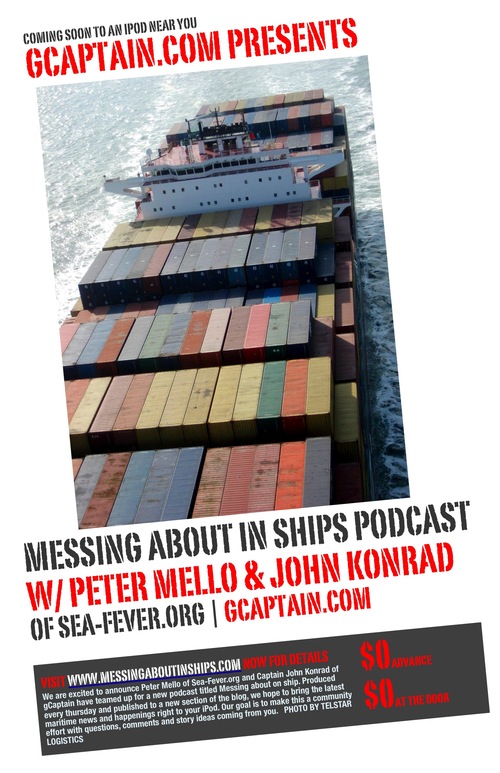Emergency management officials in New Brunswick are considering adopting a method similar to the one used in Maine to better warn residents when a major flood is coming.
Dick Isabelle, the province's executive director of emergency services, said that he favours implementing a system where local authorities are actively engaged in alerting the public when flooding is imminent.
Faced with an ugly forecast for torrential rain and a river already near its crest, disaster officials in Aroostook County, Maine, went door to door on the night of April 29 to make sure people knew they were in danger.
Across the border in northwestern New Brunswick, however, many residents were caught off guard. Although the province issued a flood warning on April 29 for the entire length of the St. John River, it wasn't taken seriously enough by people in areas that are not prone to being submerged.
In northern Maine, to make sure nobody was unaware, police set up blockades and vans rode down streets issuing warnings over their public address systems.
"I think we have to evaluate the effectiveness of our entire system, and not be afraid to stand up and say, 'Let's see what we can do better. How can we give people the proper warning they deserve?' " Isabelle said. "My guess is that the type of system we will encourage is one where we work more closely with local authorities.
"I would say that this is an area we see as having to explore."
As of last week, nearly 500 flood victims had sought government aid in northern New Brunswick, and 1,358 people were seeking assistance overall. Approximately 130 people remained displaced and were in temporary housing.
Under fire from the Opposition in the legislature last week, Premier Shawn Graham described the province's emergency system as having worked well, but said a review would be undertaken.
The province takes out advertisements to warn residents of flooding and updates water and weather conditions on its River Watch website, and usually that is enough, the premier said.
"It is important to note that this was a severe flood; we had not seen a flood of this magnitude and severity for many generations,'' Graham said. "In fact, areas were flooded that had never flooded in the past.
"As I have always stated, a complete review of this initiative will be undertaken, and we will be looking to make improvements where we can. But the reality is that the system is working.
"The severity of the flood was not anticipated. We cannot control Mother Nature. This is an important notice for all New Brunswickers today: When emergency management issues flood warnings, precautions should be taken."
Opposition Leader Jeannot Volpé and Percy Mockler, the member of the Legislative Assembly for Restigouche-La-Vallee, argued that the warning system failed to adequately alert residents in northern communities. They also complained that communication was poor between relief agencies, and that people calling for help were transferred from one agency to another and another.
"We all know what is happening now,'' Volpé said. "It is a reaction. What I am asking is, what should be done so emergency management officials can advise people when a flood is coming? How is it that people can save some of their assets by knowing ahead of time? Not the next day, or three days after, because then it is too late.
"People have lost a lot of money and a lot of assets. They were not ready because nobody told them what was coming down."
Marty Klinkenberg is a contributing editor of the Telegraph-Journal. He can be reached at martyklinkenberg@hotmail.comWEATHER NOTE
Are you prepared for natural disaster
By RICH ECKE
TRIBUNE STAFF WRITER
Montana doesn't encounter many natural disasters. Earthquakes are rare, and Great Falls is on the fringe of the fault zone, although Kalispell, Helena and other cities closer to the Rocky Mountains face more danger from a quake. Big Sky Country avoids hurricanes, monsoon rains and tsunamis.Far from Tornado Alley, Montana gets an occasional twister, but it usually just throws a bunch of dirt around in this sparsely populated state.
Great Falls is one of the country's windier cities, and so are other towns along the Rocky Mountain Front, and places like Livingston. The wind may rage, but it usually doesn't kill anyone.Montana gets cold at times, and below-zero blizzards put people in danger in winter.
The state also gets freak snowstorms, like the recent one that knocked out power to much of Great Falls and the surrounding area. About 100 rural homes lost power for days.
Losing power for several hours was not a major disaster for most people, but it showed how unprepared some people are for trouble, said Judy Powell, a national Red Cross reservist who has assisted at more than a dozen disasters across the continent.
During the recent power outage, some people did not even know how to open their garage door manually, Powell pointed out. She thinks it's better to be prepared.(By the way, your garage door opener usually has a red plastic handle attached to a rope. You pull on the handle to disconnect your garage door from the electric opener. Then you can open the garage door by hand.)
Anyway, one of Montana's few natural disasters, aside from fires, is flooding."It's that time of year for floods," said Karl Christian, conservation district specialist for the state Department of Natural Resources and Conservation in Helena. Parts of Iowa, Wisconsin and other states in the Midwest certainly have gotten nailed this month, as shown by horrifying videos of houses floating down swollen rivers.
Central Montana is wetter than usual. Great Falls has enjoyed 10 inches of moisture through mid-June, already two-thirds of the rain and snow we normally get for a whole year. Fifteen inches is average.
Melting mountain snow will add to the already high Missouri River through Great Falls. Temperatures in the 80s would hasten the melt. Then all it would take is some heavy rain to send water over the river banks. Complacency is the number one thing we can't do," Powell said Sunday.
Sure, our parched landscape has sucked up most of the generous moisture so far. And flood worries will soon fade away. But Powell argues it's better to be ready. She lives next to the Missouri River south of the city, and she has reserved her brother's four-horse trailer to move all of her belongings out during an emergency.
Once in Kentucky, Powell remembers visiting with a family whose treasured family photographs had been sitting in flood waters for two days. The photos could not be salvaged. "I came home and put all of my pictures in a plastic tote and keep them on a high closet shelf," Powell said.
Think about where your family photos are and where they would be safest in your house. A leaky roof can do the same thing as a flood. Flood events set for this week
Even if we escape bad floods in 2008, we can still reminisce about some horrendous floods that have befouled Great Falls and the surrounding area over the years. During the 20th century, 1908, 1953, 1964 and 1975 were soggy, especially for west Great Falls and outlying areas. Broken dams also didn't help in some of those years.
To commemorate the pluck and vigor of people who encountered deadly floods in Montana over the years, the Missouri River Conservation Districts Council will hold a Missouri River Flood Photo Round-Up in Fort Benton and Great Falls this week. A third event will be July 14 in Helena.
If you have any neat photos of past Missouri River flooding, come to the Ag Museum in Fort Benton on Thursday, or Friday to the Mountain West Bank, 12 3rd St. N.W., from 4 to 8 p.m. both days. The Helena event is July 14 at the USDA Building, 790 Colleen Street. Local conservation district representatives will be on hand, and refreshments will be served.
At these gatherings, someone will scan your photos for you, and hear what you have to say about the flood of 1964, or, if you're 110 years old, the flood of 1908. You may want to trade stories with other flood survivors. Call Christian at 406-444-3022 or Vicki Marquis at 406-231-5818 for more information.
State works to retain hurricane relief funds
By Ana Radelat
Gannett News Service
WASHINGTON — Gov. Bobby Jindal and the Louisiana congressional delegation are working to bridge a dispute between the House and Senate over billions in hurricane recovery money for Louisiana and Mississippi.
The House plans to vote today on a $184 billion emergency spending bill that would pay for the wars in Afghanistan and Iraq and provide $5.8 billion to repair New Orleans' levees.
But the House bill contains no money for other reconstruction efforts the Senate approved in a similar bill last month. That includes $70 million for housing vouchers for low-income Louisianians at risk of homelessness and $157 million to help the state's hospitals cover expenses related to Hurricane Katrina.
The Senate bill also would provide $50 million for upgrades in the state's criminal justice system and reduce — from $1.5 billion to $1.3 billion — the state's share of the cost of rebuilding levees. Many of the Katrina-related provisions were sponsored by Sen. Mary Landrieu, D-New Orleans.
The House rejected those provisions — and about $10 billion in other local projects — to avoid a presidential veto or, failing that, win enough GOP support to override it.
President Bush had approved the money to rebuild the levees, but objected to much of the other domestic spending the Senate had included in the bill.
Complicating the chances of the state getting the extra money, the House agreed to provide billions of dollars in emergency floor relief for the Midwest.
Jindal was to meet Wednesday afternoon with retired Marine Maj. Gen. Doug O'Dell, Bush's recently appointed coordinator of Gulf Coast rebuilding, and other administration officials to lobby them on the hurricane recovery funding.
In addition, the Louisiana congressional delegation hopes to meet with House leaders early next week on the issue.
Rep. Rodney Alexander, R-Quitman, said it would be better to hand the president a final bill that includes some hurricane spending but limits other domestic spending and doesn't restrict how the war is conducted.
"We would like to see language that doesn't have poison pills," Alexander said.
The governor also said there may not be another bill moving in Congress this year that could include the hurricane recovery money, which he called "critical to Louisiana and time-sensitive."
Sen. David Vitter, R-Metairie, urged House leaders to accept the Senate's provisions because a final bill is unlikely to win White House approval.
"The president is going to veto it anyway," Vitter said.
If the House approves a pared-down bill Thursday, it will go to the Senate for consideration. But the Senate is likely to reject it in favor of the bill it approved last month, creating new delays in approving money to conduct the war.
"It looks, unfortunately, like this will pingpong down the way some more," Vitter said.
New book spells out secrets to surviving disasterTHE UNTHINKABLE: Who Survives When Disaster Strikes - and Why by Amanda Ripley, Crown, $24.95
"We all have ideas about what we might do in a [public] emergency," writes Amanda Ripley in "The Unthinkable: Who Survives When Disaster Strikes - and Why." "But we are probably wrong."
Here's the likelihood. If you aren't immobilized by profound lethargy - many are - you'll first try to convince yourself that what is happening isn't. Even when it's blazingly obvious that you have to get out, you may feel a strong urge to stay put.
If you're very lucky, someone may break through that denial by shouting a directive, "We have to move!" What you do next will be really stupid. You'll look for your handbag or root for whatever in your desk drawer. If you aren't dead by the time you find it, carrying it will complicate your escape.
Chances are you will be fleeing with a crowd and someone has taken command. But even as you move to safety, if not before, your body will betray you. Your vision could narrow dramatically. You might go temporarily blind. You will forget how to do simple things. Unbuckling a seat belt, for instance, may seem so terribly complex.
Ripley, who reported on disasters and now covers homeland security for Time, became fascinated with all facets of human response to disaster, and "The Unthinkable" is the valuable product of her determined pursuit of answers.
Physiology (the amygdala, specifically) plays a role, as does evolution and genetics. Your intuitive response can help, but if it's your sole guide, it can lead you badly astray. It's a matter not only of knowing yourself but knowing your disaster - the one you're most vulnerable to. As an expert points out, "Disasters have personalities." Some strike more debilitating fear than others. Learning the facts can override that at a critical juncture.
Training is the most essential tool of all. Ripley's pressing point is that all our sophisticated warning systems and emergency procedures are designed to meet the needs of professionals. Civilians are considered a grade below, not to be trusted, though in many, if not most disasters, waiting to be saved can be deadly.
"We were the first responders," says a 9/11 survivor who escaped the World Trade Center.
We are a country built on self-sufficiency, Ripley writes, but we refuse to give ordinary people the information that, when delivered in factual and nonthreatening terms, can save their lives. Perhaps it's time for the rest of us, the potential victims, to signal a Code Red. We need to know. Now.
Our disaster personalities are quite different from our everyday selves.
Milling about gathering information can be useful in some disasters. Just don't prolong it.
Do not, repeat do not, give in to the impulse to gather luggage, handbags or anything. Just get out.
Disaster induces a paralytic lethargy in many people. Sometimes this works to save you. Usually not. Fight it.
Of all passengers involved in serious airplane accidents between 1983 and 2000, 56% survived. But you have seconds, sometimes 90, sometimes less, to get out.
Read the safety diagram on airplanes. Wherever you are, know your exits. Count the rows on a plane. In a fire, always stop, drop and roll.
Fire kills more Americans annually than all other disasters combined. In a hotel, take the stairway down to the ground once to become familiar with the crossovers and other surprises.
Worry about probability. What kind of disaster is most likely to strike your area. Hurricane? Flood? Terrorist attack? Learn what to do in that situation. Train yourself. Then you will be response ready.
Don't be silly about sharks. Worldwide, six humans are fatally attacked annually, while human beings kill between 26 million and 73 million sharks. We're way ahead on this one, folks.
MARITIME NOTE
More problems for RiverdanceTREACHEROUS weather conditions and shortening summer tides are hampering workmen's efforts to dismantle the wrecked Riverdance ferry.
Bosses at the ship, which is being dismantled on the Anchorsholme coastline, say conditions were so poor last weekend when gushing winds battered the Fylde coast that work on the vessel had to be abandoned on Sunday.
Officers have also warned progress has been slowed by the fact time to work between the tides has been halved as the demolition job heads into the summer.
Donald McDonald, who is overseeing the operation for the Maritime and Coastguard agency, said: "With the high winds on Sunday it would have been dangerous to put people in the situation.
"We don't normally have this kind of weather at this time of year."
GAO Issues Report on Loss of Coast Guard Patrol Boats
U.S. Government Accountability Office's just-issued report; COAST GUARD: Strategies for Mitigating the Loss of Patrol Boats Are Achieving Results in the Near Term, But They Come at a Cost and Longer Term Sustainability Is Unknown (GAO-08-660).
The GAO accomplished this report for the Senate Commerce Committee, Subcommittee on Oceans, Atmosphere, Fisheries and Coast Guard. The report provides some background on the Coast Guard's "bridging strategy" to upgrade aging patrol boats from 110 feet to 123 feet (to include a number of upgrades and stern-launch boat ramp) as part of its Deepwater program. After the Coast Guard upgraded 8 of these boats, the hulls developed hull deformities and other problems and these 123 foot boats were pulled from service.
Most of the report discusses the Coast Guard's strategies for dealing with the loss of these boats and its impact on District 7 (waters off Florida, and some adjoining states) where all of them were based. One of the main Coast Guard homeland security missions in this district is the interdiction of migrants. The Coast Guard strategies to replace operational hours in District 7 included: double-crewing existing patrol boats, deploying patrol boats to District 7 from adjacent districts, using Navy patrol boats, increasing operational hours of other patrol boats, and revising boat maintenance programs. While these strategies have been successful in raising patrol boat operational hours in District 7, they have also raised certain costs and diverted some missions in adjacent districts. For example, adjacent districts are doing less enforcement of marine fisheries and less maintenance of aids-to-navigation. This fits into a broader theme of GAO work that demonstrates that the Coast Guard is having difficulty meeting all of its mission requirements (particularly non-homeland security missions) within the current level of resources. The Coast Guard will have to maintain these increased costs (both in dollar expenses and mission opportunity costs) as it awaits the deployment of new smaller less capable 87 foot patrol boats, and a new generation of boats known as Fast Response Cutters.
This briefing comes courtesy of Stephen L. Caldwell / Director, Maritime Security Issues / Homeland Security and Justice Team / U.S. Government Accountability Office / (202) 512-9610. Click HERE to read the full report.
Waterspouts seen over Lake Erie
Published: June 19. 2008 11:53AM
Shipping firm to sue Philippine weather agency for mishap
Manila, June 27 (Xinhua) The owner of a Philippine ferry that sank in the devastating Typhoon Fengshen with more than 800 people on board said Friday he would sue the country’s weather agency for not giving timely information about the typhoon. According to Philippine TV network GMA News, shipping company Sulpicio Lines, which owned the sunken ship MV Princess of the Stars, said it would charge the Philippine Atmospheric, Geophysical and Astronomical Services Administration (Pagasa) next week for failing to update the ship’s crew about the movement of Typhoon Fengshen.
At least 70 passengers were confirmed killed when the MV Princess of the Stars sank off Sibuyan Island, 300 km south of Manila. More than 740 people are still missing and feared dead, while 48 have survived the accident - the worst in the past two decades.
Sulpicio Lines’ lawyer Arthur Lim said the shipping company will charge Pagasa with gross incompetence and negligence, saying that the ferry could have averted the tragedy had Pagasa issued an additional warning on the typhoon’s movement.
Lim said the ship’s route from Manila to Cebu was not completely reflected in the Pagasa bulletin they received before sailing.
At the Board of Marine Inquiry investigation earlier Friday, Nestor Ponteres, Sulpicio’s port captain in Cebu, claimed that the company was informed six hours late by Pagasa regarding typhoon Fengshen’s changing course.
Ponteres also claimed he was in constant communication with the ferry’s captain, Florencio Marimon Sr, before the ship sank. Marimon is still missing.
Ponteres added that there were alternate routes that the ship could have taken had the warning been relayed earlier.
But Pagasa director Prisco Nilo said that they always make sure to release weather updates to the public even though predicting the behavior of a typhoon cannot always be precise.
“Anywhere you go, the warnings and the bulletins are updated a number of times in a day, usually four times a day taking into consideration that (weather) forecasting is not an exact science,” Nilo said, adding that shipping companies also have the responsibility to closely monitor the weather condition to ensure its vessels’ safety.
Sulpicio Lines had earlier blamed the Philippine Coast Guard for the tragedy, saying Wednesday that it was the Coast Guard’s task to plot routes for vessels during inclement weather.
The Board of Marine Inquiry, however, said the 1998 memorandum circular on which Sulpicio Lines based its arguments had been replaced with an updated June 2007 memorandum circular that places responsibility on the ship’s owner and captain.
RS



































































































![Validate my RSS feed [Valid RSS]](valid-rss.png)